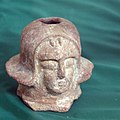File:Axumite Jar Spout (2822628227).jpg

Yanayin wannan rigayi gani: 601 × 599 pixels. Wasu yarjejeniyoyi: 241 × 240 pixels | 481 × 480 pixels | 770 × 768 pixels | 1,027 × 1,024 pixels | 1,659 × 1,654 pixels.
Hoton asali (pikisal 1,659 × 1,654, girman fayil: 920 KB, irin MIME: image/jpeg)
Tarihin fayil
Ku latsa rana/lokaci ku ga fayil yadda yake a wannan lokaci
| Rana/Lokaci | Wadar sufa | Kusurwowi | Ma'aikaci | Bahasi | |
|---|---|---|---|---|---|
| na yanzu | 17:40, 5 Oktoba 2012 |  | 1,659 × 1,654 (920 KB) | File Upload Bot (Magnus Manske) | Transferred from Flickr by User:Elitre |
Amfani da fayil
Wadannan shafi na amfani wannan fayil:
Amfanin fayil a ko'ina
Wadannan sauran wikis suna amfani da fayil din anan
- Amfani a kan arz.wikipedia.org
- Amfani a kan azb.wikipedia.org
- Amfani a kan en.wikipedia.org
- Amfani a kan hy.wikipedia.org
- Amfani a kan ja.wikipedia.org
- Amfani a kan ro.wikipedia.org
- Amfani a kan ru.wikipedia.org
